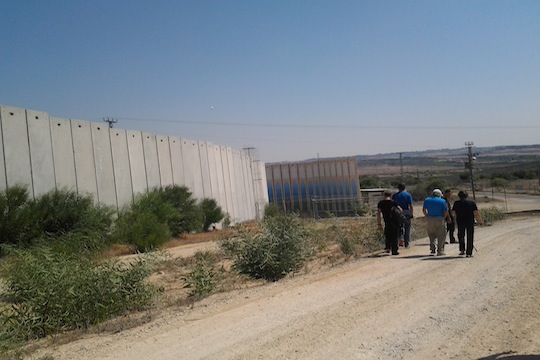Since 1994, activists in the Italy’s Susa Valley have been engaged in a popular struggle against government plans to build a 57 kilometer high-speed railway. On a trip to the West Bank, the Susa Valley activists came to better understand life under Israeli occupation, and came away with new insights for their own struggle back home.
By Riccardo Carraro

When we use the term “popular struggle” we usually mean it in the context of collective, grassroots participation in a fight that is inclusive of several sectors of society, without distinction based on gender, age, culture, etc. And although each popular struggle has its own specificities and characteristics, there are common elements shared by all popular struggles: rejection of a strict division of labor, determination to participate, to take back one’s life, as well as one’s personal and communal destiny.
All popular struggles have in common the capacity to choose, claim dignity, and react to violence, repression, and abuse of power. A struggle becomes “popular” when it is not implemented solely by leaders but by common people. A struggle is popular when both the elderly and young can participate, each one through their own contribution.
In a popular struggle, the process of “activation” is as important as the results you achieve, it is precisely through that process that one obtains the greatest outcomes.
I recently returned from a journey to Israel/Palestine with a delegation of Italian activists from the Susa Valley. During our trip we visited various local groups engaged in popular struggle, including in Nabi Saleh, Al-Araqib, Bil’in, South Hebron Hills and Jaffa.
Since 1994, the Susa Valley has been the site of NO TAV, a popular struggle against the construction of a high-speed railway in the valley. This railway, with its 57-kilometer tunnel, will destroy the environment of the valley, damage several water sources, and worsen the health of local residents (the mountain section of the tunnel contains large amounts of uranium and asbestos). Furthermore, the train line is useless, as there is already a modern railway track that is only functioning at 20 percent of its full capacity. The project will cost the public nearly 40 billion euros, with politicians daring to say that it will be used for the transportation of goods.
Italy is a paradoxical country in which 40 percent of youth are unemployed and where public services (schools, hospitals, public transportation) are being dismantled. Now the state is about to spend at least 40 billion euros in order to allow potatoes and onions to travel at 300 kilometers per hour between Turin and Lyon – very useful indeed. The locals reacted to the government’s decision with demonstrations, direct actions, and other nonviolent means. However, the government cracked down on the protests, wounding many, indicting more than 900 activists, heavily militarizing the valley while deploying thousands of policemen and soldiers to defend the construction.

The journey to Palestine/Israel was organized by the Italian NGO Servizio Civile Internazionale, which has backed both the Susa Valley popular struggle and the popular struggle in Palestine/Israel for years. During the trip, Italian activists were able to learn about and understand the struggle against the occupation, while sharing insights from their experience with both Palestinian and Israeli activists.
Palestinian activists were amazed to discover what was taking place in Italy; similarities between the two struggles became clearer with every passing day, all the while recognizing that the Israeli occupation is a much more violent and sophisticated system of oppression than the one taking place in the Susa Valley.
The most interesting similarities were found not in external aspects such as tear gas or barbed wires, but rather in hidden aspects that came out in the process of long talks. In Al-Araqib, we learned about sumud, or holding steadfast to one’s own land against dispossession and eviction, a concept which greatly resonated with the people of Susa Valley.
Furthermore, it was interesting to note the ways in which both the Italian government and the Israeli government used force to control and curtail resistance (arrests, expulsion orders or house arrest for activists are very common in both places). While we were in Palestine, one leader of the Susa Valley struggle had his house raided and was indicted for incitement – something many leaders of the Palestinian popular struggle have experienced firsthand.
Both groups of activists found it disturbing that people can live a normal life just 40 minutes away from areas under occupation. During one talk, Israeli activists shared what it means to live in Tel Aviv. I could not help but compare Tel Aviv to Turin, a city just 40 minutes outside of the Susa Valley that often feels so disconnected from the military occupation of the area.
Both groups also saw how labor exploitation was common to both Susa and Palestine, whether through learning about how Palestinians find work by building West Bank settlements, or how unemployed Italians find work in constructing the railway. This allowed activists to share the ways in which businesses are profiting off both occupations, and gave us and understanding of the Boycott, Divestment and Sanctions (BDS) movement.
One recurring theme that emerged several times throughout the trip was the way in which activists who engage in popular struggle do not fight solely for their own rights and freedoms, nor for rights and freedom of their community. They are struggling for rights and freedom of oppressed people beyond their own country. Thus, the symbolic power of popular struggle – the paradigmatic clash between people and power – can serve as a source of inspiration for other struggles abroad.
Riccardo Carraro is an Italian activist, who has been actively involved in Israel/Palestine issues since 2003. He is currently the Secretary of Servizio Civile Internazionale, an Italian NGO committed to human rights, peace and social justice.
